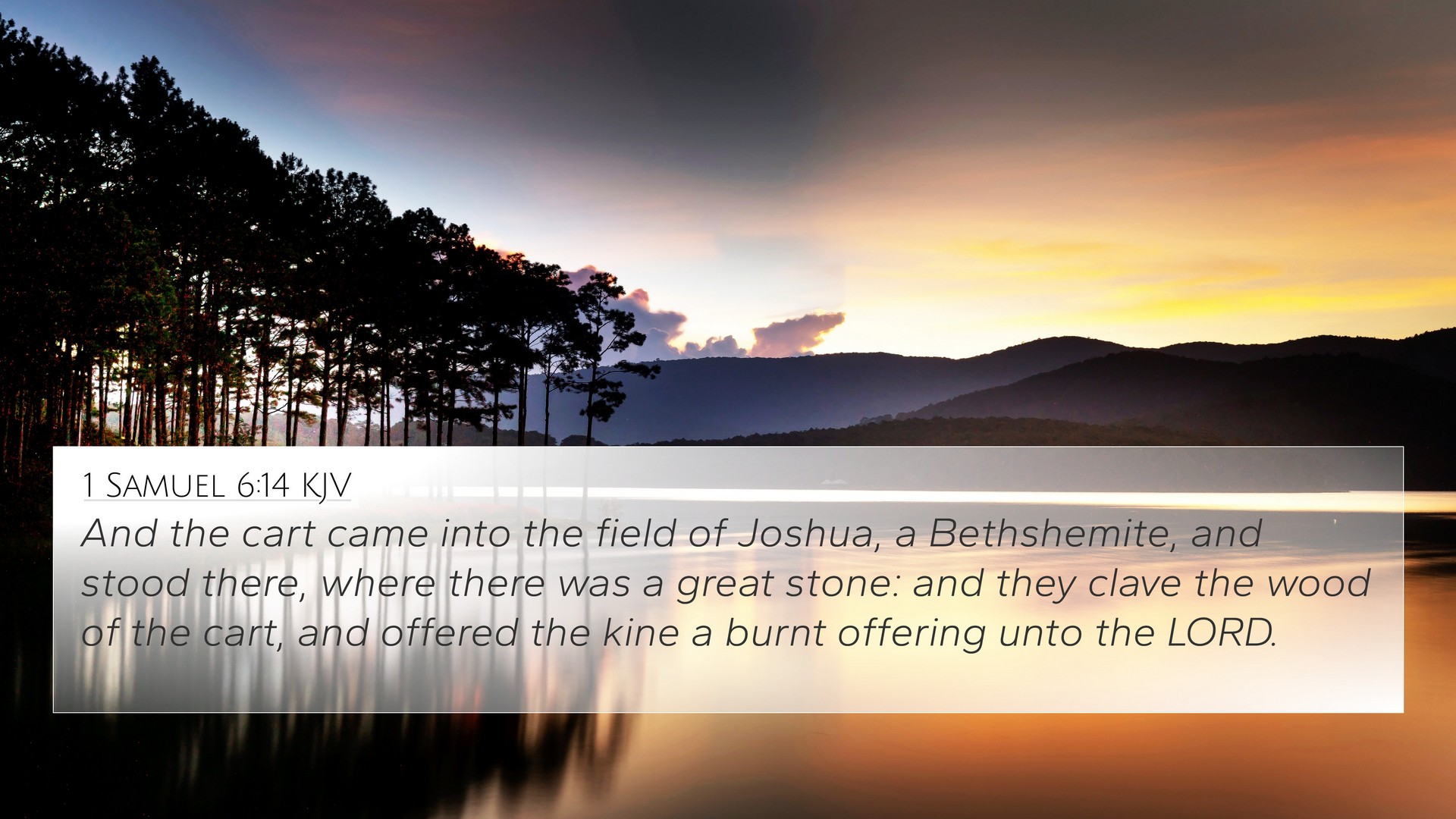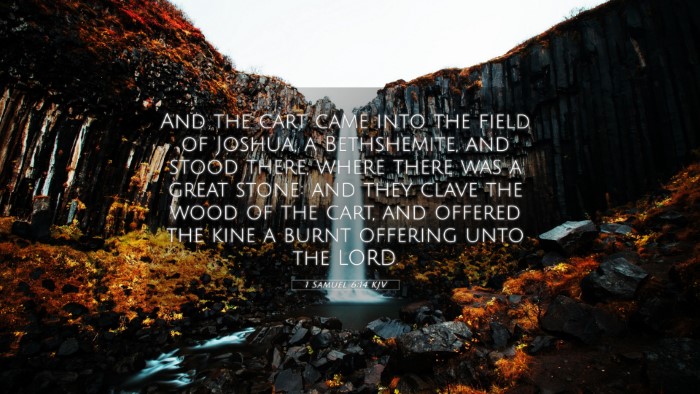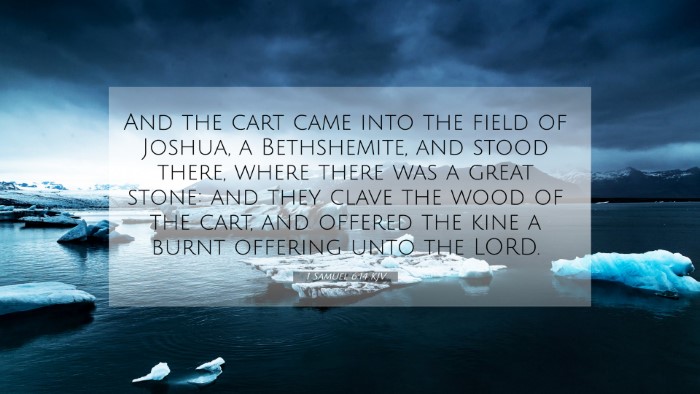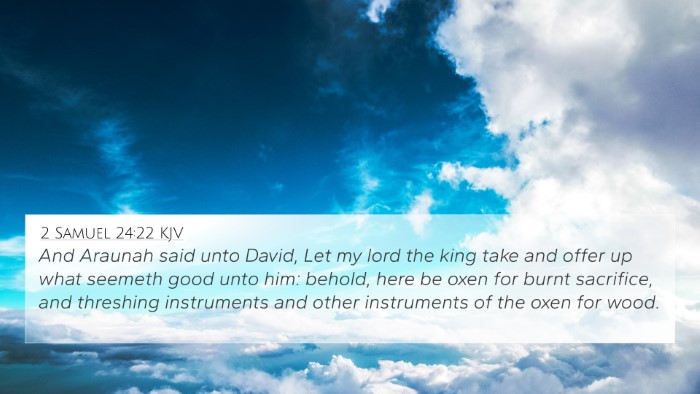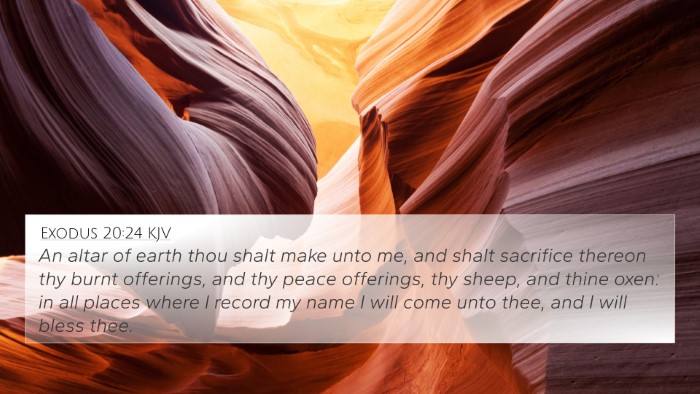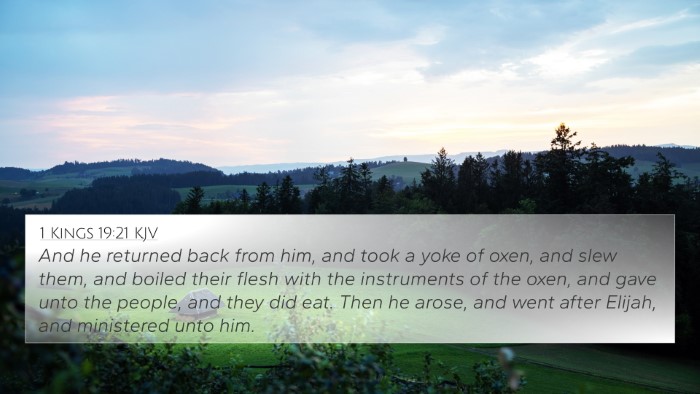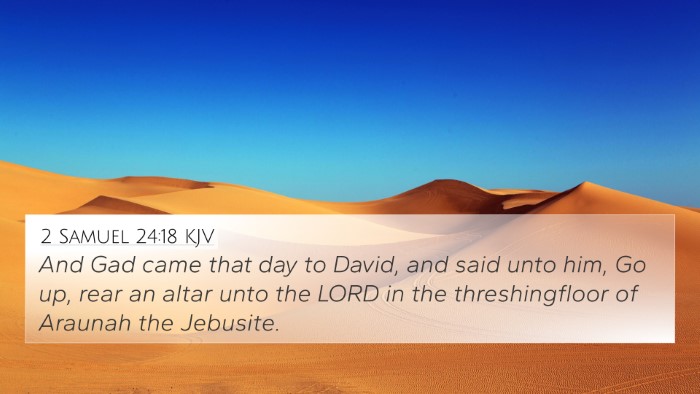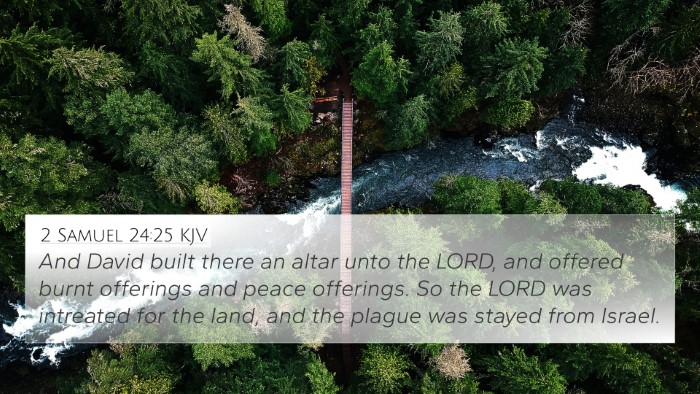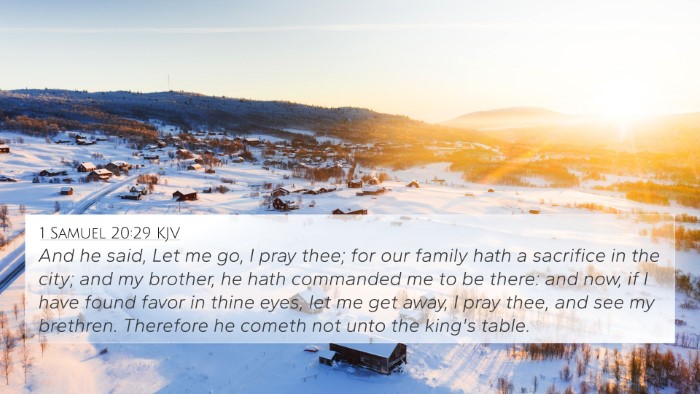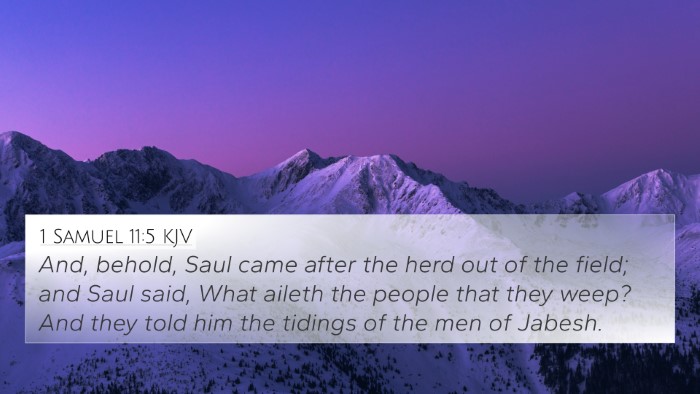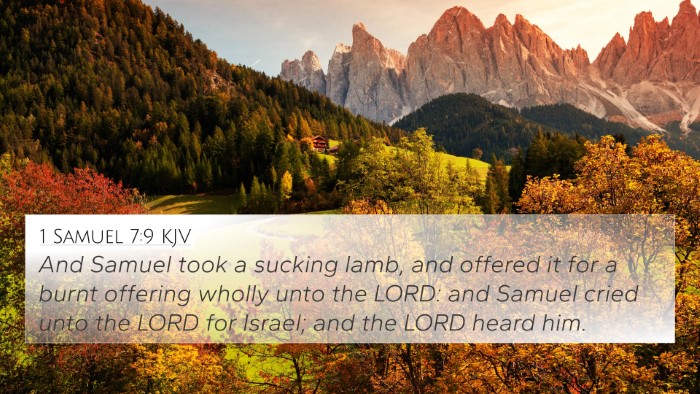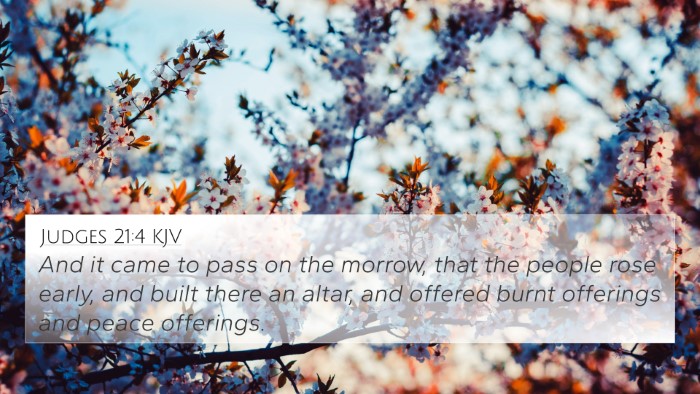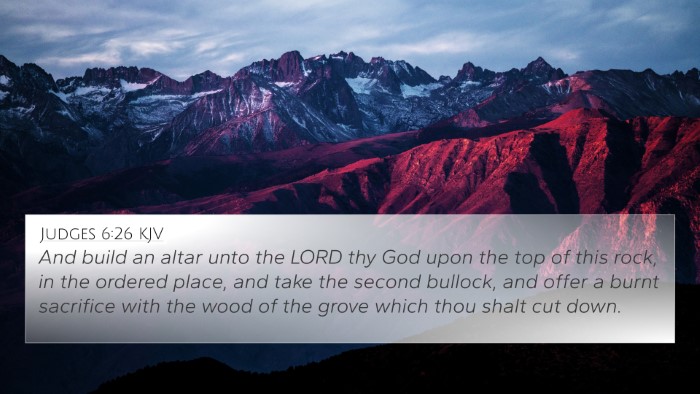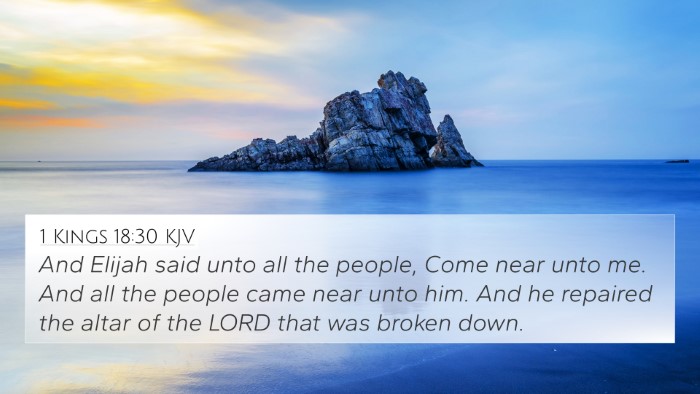Meaning and Interpretation of 1 Samuel 6:14
Bible Verse: 1 Samuel 6:14 - "And the cart came into the field of Joshua of Beth-shemesh, and stood there. A great stone was there: and they clave the wood of the cart, and offered the cows a burnt offering unto the LORD."
This verse captures a significant moment when the Philistines return the Ark of the Covenant to Israel after experiencing calamities. The journey of the Ark culminates at the field of Joshua in Beth-shemesh.
Contextual Background
To fully appreciate this passage, it's essential to understand the larger narrative surrounding the Ark of the Covenant. The Ark was a symbol of God's presence, and its capture by the Philistines had dire consequences for them. The subsequent return of the Ark, as described in this verse, symbolizes restoration and the return of divine favor.
Commentary Insights
- Matthew Henry: Henry observes that the act of the cart standing in the field of Joshua signifies a purposeful and divinely directed journey. The great stone upon which the offerings were made was likely an altar, emphasizing the importance of sacrifice and worship upon the Ark's return.
- Albert Barnes: Barnes expounds on the significance of the burnt offering presented by the men of Beth-shemesh. He explains that this offering was a form of thanksgiving and acknowledgment of God's mercy in returning the Ark. The actions taken by Joshua's field illustrate the reverence and piety that the Israelites maintained towards God’s presence.
- Adam Clarke: Clarke highlights the symbolic nature of the cows drawing the cart, suggesting that they were a representation of obedience. The cutting of the cart's wood to create an altar for sacrifice underscores the relationship between God’s guidance and human response in worship.
Bible Verse Cross-References
This verse connects to numerous other passages that reinforce its themes of divine presence, sacrifice, and restoration:
- Exodus 25:22: "And there I will meet with you, and I will speak with you from above the mercy seat, from between the two cherubim which are upon the ark of the testimony." - This illustrates God’s intention to dwell among His people.
- 1 Samuel 7:9: "And Samuel took a suckling lamb, and offered it for a burnt offering wholly unto the LORD: and Samuel cried unto the LORD for Israel; and the LORD heard him." - Reflecting the importance of offerings when seeking God’s favor.
- Leviticus 1:3: "If his offering be a burnt sacrifice of the herd, let him offer a male without blemish: he shall offer it of his own voluntary will at the door of the tabernacle of the congregation before the LORD." - Describing the principles of burnt offerings in worship.
- 2 Samuel 6:13: "And it was so, that when they that bare the ark of the LORD had gone six paces, he sacrificed oxen and fatlings." - A reminder of the reverence associated with transporting the Ark.
- Psalms 51:17: "The sacrifices of God are a broken spirit: a broken and a contrite heart, O God, thou wilt not despise." - Further emphasizing the nature of acceptable sacrifices to God.
- Hebrews 10:4: "For it is not possible that the blood of bulls and of goats should take away sins." - This verse deepens the understanding of spiritual sacrifice beyond the physical.
- Philippians 4:18: "But I have all, and abound: I am full, having received of Epaphroditus the things which were sent from you, an odour of a sweet smell, a sacrifice acceptable, well pleasing to God." - Connecting New Testament ideas of sacrifice and pleasing God.
Thematic Bible Verse Connections
1 Samuel 6:14 aligns with several themes throughout scripture, such as:
- Divine Restoration: The return of the Ark signifies God's willingness to restore His covenant relationship with Israel after the hardship of its absence.
- Worship and Sacrifice: The act of offering burnt offerings underlines the importance of proper worship and the acknowledgment of God’s sovereignty.
- God’s Presence: The Ark's journey and subsequent return highlight the significance of God’s presence among His people, which is a recurrent theme throughout the Bible.
Cross-Referencing Biblical Texts
Utilizing a Bible concordance or a Bible cross-reference guide can enhance one's understanding of scriptures. These tools can help identify connections between verses, allowing a deeper exploration of themes and teachings. For example:
- Identifying Connections: When studying 1 Samuel 6:14, look for parallels in similar narratives, such as the return of the Ark in 2 Samuel, to grasp the thematic continuity.
- Comparative Bible Verse Analysis: Analyze the similarity in worship practices through offerings in both the Old Testament and New Testament contexts.
- Thematic Bible Verse Connections: Explore how themes of worship and sacrifice in 1 Samuel connect to New Testament teachings of individual worship and the ultimate sacrifice of Christ.
Inter-Biblical Dialogue and Spiritual Reflections
The act of returning the Ark can also prompt spiritual reflections on how worship is offered today, and how believers view the presence of God in their lives. The interconnectedness of scripture invites believers to engage in deeper study and contemplation.
Conclusion
1 Samuel 6:14 serves not only as a historical account but as a rich tapestry of theological insights and reflections on worship, restoration, and divine presence. Through cross-referencing with other biblical texts, believers can better understand the significance of this passage and its implications for worship and reverence toward God.
